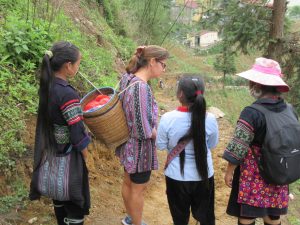Around the world with Julie and Marc: Good morning (from) Vietnam
Hi… or as they say in Vietnam… Xin Chào!

Julie making friends with regional tribe members during a hike through the mountains
Vietnam was actually a last-minute destination added to our itinerary, thanks to recommendations from the many people we encountered during our travels over the past several months. With such rave reviews, how could we not check it out for ourselves, right?
Of course the first stop when you enter a new country—get some dongs.
At least that’s what they call the currency in Vietnam.
Oh, and an important financial tip when travelling: be sure to know the value of the local currency in Canadian dollars—because after a withdrawal from a local ATM, we ended up with more than 5 million dongs. But thankfully after a quick double-check of the dongs-to-dollar comparison, we confirmed that we had only withdrawn $300 Canadian (1 Canadian dollar = 17,000 Vietnamese dongs).
Once we had our dongs, our next dilemma was how to cross the road.
That’s because traffic in Hanoi is extremely chaotic. So to say that we were extremely nervous standing along the roadside would be an understatement (picture the equivalent of standing at the side of a major busy highway in Canada, except without any breaks in traffic). But after watching how the locals do it, we soon mastered the art of road crossing.
Next stop—Old Quarter.
We stayed in the Old Quarter of Hanoi, which ironically enough was filled with the non-stop sound of honking cars (we’re guessing it must have been much quieter back in 3,000 BC when the city was first inhabited).
Yet what the city lacks in silence, it more than makes up for in culture.
Sitting on the banks of the Red River, Hanoi is flowing with various cultural influences—namely Chinese and French. For example, it’s common to see buildings around the city influenced by French architecture, yet decorated with red lanterns (influenced by Chinese culture).
In this particular area of Hanoi (Old Quarter) lies the ‘36 Old Streets’ section, where each street is named after a specific type of product being sold there (i.e. ‘Pho Ngin Street’ sells hats, ‘Pho Giay Street’ sells paper, ‘Hang Gai Street’ sells silk, etc).
Also well known for its culinary heritage, the Old Quarter is THE place to sample delicious street fare as you take in the sights.
We savored some of its most famous dishes, like ‘pho’ (a noodle soup enjoyed all hours of the day, especially for breakfast), ‘bun cha’ (rice noodles served with marinated grilled pork), ‘pho ga’ (chicken noodle soup), and ‘banh mi’ (the famed French-inspired Vietnamese baguette).
While there are very few sweets in the traditional Vietnamese cuisine, we were lucky enough to discover ‘banh it nhan dau (balls of sticky rice and sugar with bean paste in the middle)—very tasty.
Of course when in Rome (or Hanoi in our case), cook as the locals do.
After a basic lesson of the language and a trip to the market to shop for (and negotiate the prices of) fresh produce—a traditional cooking class gave us some valuable (and delectable) insights into the secrets of Vietnamese flavours.
The end result of our crash course in local food preparation was a flavourful menu that consisted of:
- Stuffed eggplant
- Spring rolls
- Bethel leaves pork rolls
- Banana flower salad
- Kholrabi soup
- Custard apple fruit for dessert
To add to the authentic Vietnamese experience, we took a cyclo to the market instead of a bicycle. A cyclo is basically a three-wheeled bicycle taxi (with Marc as the operator and Julie in the passenger seat). Let’s just say we now have a greater respect for the strong-legged individuals that take tourists all around the Old Quarter in these cyclos, day in and day out.
After an enlightening time in Hanoi, it was off to discover the treasures of the northern part of Vietnam.
To take us on this journey, we chose a 12-day private tour with a Vietnamese-owned company based in Hanoi that offers cooperative opportunities for local families. In a country where the annual average salary is $2,300 U.S., having the ability to offer lodging, meals, and boat/bicycle/kayak rentals is a good way for locals to raise a few extra dongs.
Among the highlights of our 12-day northern odyssey was trekking with our local guide through small, peaceful villages, rich farmlands, sculpted rice terraces, and towering mountains. Along the way we had the privilege to interact with members of a number of local tribes including the H’mong, Thai, Tay, Muong, Khmers, and Chams. We even had the opportunity to participate in homestays, which helped us to see firsthand the unique lifestyle and culture of the peoples in this region.
Other breathtaking sights we experienced on our northern Vietnamese journey:
- Crossing the gigantic mountain passes of the Tonkinese Alps
- Hiking the dramatic trails of Cuc Phuong National Park
- Biking through spectacular mountain ranges, rich forests, and limestone panoramas
- Exploring Nin Huan and Tam Coc in a boat ride along the canal—taking in the view of huge rock formations rising out of rice paddies
- Discovering Halong Bay (in the Gulf of Tonkin), which is a UNESCO World Heritage Site known for its 3,000 pinnacles that rise from the sea, where the islets are dotted with caves created by wind and waves—a true vision of breathtaking beauty!
- Living, eating, and sleeping on the water for 24 hours during a boat trip that introduced us to night fishing for calamari and subjected us to majestic and mysterious bays, accented by unusual rocks and islets emerging from the sea
Goodbye Vietnam…
From its palate-pleasing foods, wondrous landscapes, and rich history (which includes a very turbulent past)—we discovered a lot about this resilient little country on the South China Sea. But what impressed us the most is the unrelenting kindness and tenacity of the Vietnamese people. Experiencing Vietnam through their eyes has given us a memory-filled journey that we will cherish forever.
Tam biêt (bye),
Julie and Marc
A few facts about Vietnam:
- Eating at restaurants in Hanoi can sometimes be a challenge—not because of the food—but due to the short-legged chairs that seem to be made for first-graders (yet it’s all is part of the charm)
- Vietnamese coffee is strong and can include unique extras—such as blending sugar and egg yolk with coffee, or incorporating sweetened condensed milk
- Liberation Day is celebrated on April 30th, a date on which north and south of Vietnam reunited back in 1975 (which is also the year Educators Financial Group first came into being!)
- A thousand years ago (during the rainy season and floods in northern Vietnam), a special art form was invented by rice farmers using rice paddies—still alive today, water puppetry using wooden puppets can be seen (especially in Hanoi), accompanied by musical performances on traditional instruments
- Life in Vietnam revolves around family, so it’s common to find several generations living under one roof
Did you know that Educators Financial Group helped Julie and Marc put a financial plan together to save for their yearlong global adventure?
If you have dreams of taking a deferred salary leave, contact us. We’d be happy to help you work towards taking a year away, however—and wherever—YOU want.


